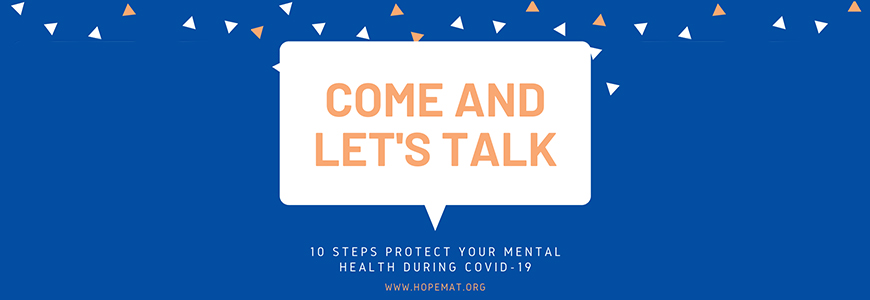
Mental health disorders are frustrating even in the best of times. In the face of the COVID-19 pandemic, people with mental health issues may experience increased symptoms and, as a consequence, are at higher risk for adverse outcomes, even if they don’t get sick with COVID-19 themselves.
Most psychiatric disorders are associated with reduced tolerance of stressful events, and some mental health illnesses include diminished awareness of social events. These traits may cause someone to fail to follow isolation and quarantine instructions, which puts them and others at risk for exposure to the coronavirus.
The direct effects of COVID-19 affect everyone, but people with mental health disorders face unique challenges and additional risks for negative outcomes. Tens of millions of Americans are experiencing newfound unemployment. For people with psychiatric disorders, the consequences of job loss can be even more devastating than for healthy people.
The stress of unemployment, financial hardships, loss of trusted providers, and a near-complete loss of access to healthcare is more than enough to drive even the healthiest of people to a state of confusion, fear, and despair. Joblessness and financial hardship significantly increase the risk for impaired mental health and depression, and a reliable predictor of poor mental health is unemployment.
Mental health disorders have long been recognized as key factors in homelessness, and an estimated 30% of chronically homeless people have a psychiatric illness. As COVID-19 continues to devastate communities, rising homelessness and substance abuse will increase, and people with mental health illnesses are at increased risk.
As social distancing, travel restrictions, and isolation become the status quo, access to healthcare providers, counselors, friends, and loved ones drops quickly. The result is an abrupt loss of access to support structures and mental health services, which are often requirements for people who are successfully managing their symptoms.
As a direct result of COVID-19, we can expect to see increasing prevalence and severity of psychiatric disorders as people struggle to access healthcare and prescription refills. Social isolation will further exacerbate symptoms. Unfortunately, this population will face serious, even life-threatening indirect effects as well.
The indirect effects of COVID-19 can be as (or more) dangerous than COVID-19 itself. Social distancing, isolation, quarantines, and fear of coronavirus infection can all increase stress levels and may worsen serious psychiatric symptoms.
Emotional stress and uncertainty regarding COVID-19 increases the risk that someone will turn to drugs or alcohol to help them manage their symptoms, especially if they lose access to their prescription medications. People with mental health disorders are more likely to develop a substance use disorder than the average person. Boredom and loneliness that are caused by social isolation may also increase substance use.
People with psychiatric illnesses are at increased risk for homelessness, which is incompatible with social distancing, isolation, and quarantines. Being homeless increases exposure risk while simultaneously reducing access to healthcare and financial support, and experts predict that homeless populations will grow as a result of COVID-19, which will lead to COVID-19 deaths among the homeless to become more frequent than in other populations.
The fact that we, as a society, fail to provide even rudimentary healthcare or basic support (e.g., access to food and social programs) to homeless people is consistent with the prediction that both long-term and newly homeless people will face significantly more severe consequences from COVID-19 than the rest of us.
Developing COVID-19-like symptoms can be devastating for someone with a psychiatric disorder. There are three significant harms that stigma can cause. First, people may be shunned by members of the public, friends, and even family, which increases social isolation. Second, people who have been stigmatized may feel ashamed and internalize disrespectful stereotypes, which contributes to depression and anxiety.
The third critical harm that stigma causes are “label avoidance,” when people are so afraid of being labeled as infected, they actively avoid being tested and treated for COVID-19. Label avoidance increases morbidity and mortality because when sick people hide their condition, they don’t receive appropriate treatment and are more likely to transmit the virus to others.
COVID-19 poses a grave challenge to people with mental health disorders. However, people without pre-existing psychiatric illnesses are also at increased risk for worsening mental health status, which may push them into serious mental health illnesses such as clinical depression, anxiety disorder, or substance use.
How to protect ourselves
There are steps we can take to limit the stress associated with the COVID-19 pandemic and protect our mental health:
- Be proactive about protecting yourself to reduce stress and anxiety and improve mental health and emotional wellbeing. Follow guidelines issued by the CDC to protect yourself and your loved ones, and avoid using any illicit substances or alcohol during this time.
- Turn off the news! Our 24-hour news cycle depends on sensational stories that may not deliver accurate information, and studies have found that increased exposure to the media is correlated with increased stress responses and worsening mental health.
- Get COVID-19 information and updates only from reputable sources (e.g. the CDC ). This will limit the amount of uncertainty and fear surrounding the pandemic.
- Avoid social isolation. Beat loneliness by using Audio Visual communication channels such as , Zoom, Skype or Facetime for face-to-face interaction with loved ones. Even texting or talking on the phone can provide the social stimulation we need to protect ourselves from isolation.
- Stay positive. Worrying about vague predictions and half-truths carelessly tossed around by non-experts will have negative consequences on anyone’s emotional wellbeing. Practice gratefulness and mindfulness by being aware of the positives in your life.
- Keep your doctors’ appointments. Many healthcare professionals are turning to telehealth to maintain oversight of patients and make sure prescriptions are being refilled. Even group therapy sessions are successfully being held remotely.
- Eat a healthy diet. In order for your immune system to protect you effectively, it needs important nutrients that come from fruits, veggies, and healthy proteins. Sticking to consistent mealtimes can also help you maintain mental and physical health.
- Exercise is more important now than ever, but even getting outside can be a challenge. Luckily, there are plenty of mobile apps and at-home workout routines ranging from yoga and Pilates to strength training. Aerobics in your living room might not be quite as rewarding as it is in a class full of friends, but it will keep your mind and body healthy. Try to walk at least 30 minutes two times a day.
- Develop and maintain a routine. If you’re suddenly working from home, you might be tempted to work from the comfort of your bed. However, sticking to a regular bedtime and waking schedule and designating a work area will increase productivity and sharpen the boundaries between home and work life.
- Be present, and don’t worry about things you can’t control. We all know we’re supposed to practice mindfulness and cultivate inner peace, but the truth is most of us aren’t very good at it. Luckily, there are some great resources that can help. For example, the UCSD Center for Mindfulness offers free guided meditations and other resources [12].
Additional resources
If you or someone you love is struggling, help is available [13]:
- Disaster Distress Helpline (SAMHSA)
Call 1-800-985-5990
Text TalkWithUs to 66746 - National Suicide Prevention Lifeline
Call 1-800-273-8255
Chat with us at https://suicidepreventionlifeline.org/chat/ - Crisis Textline
Text TALK to 741741 - Veterans Crisis Line (VA)
Call 1-800-273-8255
Text 838255 - National Domestic Violence Hotline
Call 1-800-799-7233
COVID-19 is testing our global community in ways that were unthinkable a year ago. As we re-adjust to our new reality, it’s more important than ever that we take care of ourselves and others. Stay safe, but don’t let COVID-19 force you into isolation. Make sure you get a healthy diet, exercise, and take steps to maintain contact with your healthcare providers.
References
- Batic-Mujanovic, O., et al., Influence of Unemployment on Mental Health of the Working Age Population. Materia socio-medica, 2017. 29(2): p. 92-96.
- Yao, H., J.-H. Chen, and Y.-F. Xu, Patients with mental health disorders in the COVID-19 epidemic. The Lancet Psychiatry, 2020. 7(4): p. e21.
- Caton, C.L.M., et al., Risk factors for long-term homelessness: findings from a longitudinal study of first-time homeless single adults. American journal of public health, 2005. 95(10): p. 1753-1759.
- SAMHSA. Current Statistics on the Prevalence and Characteristics of People Experiencing Homelessness in the United States 2011 [cited 2020 May 8]; Available from: https://www.samhsa.gov/sites/default/files/programs_campaigns/homelessness_programs_resources/hrc-factsheet-current-statistics-prevalence-characteristics-homelessness.pdf.
- Santini, Z.I., et al., Social disconnectedness, perceived isolation, and symptoms of depression and anxiety among older Americans (NSHAP): a longitudinal mediation analysis. The Lancet Public Health, 2020. 5(1): p. e62-e70.
- Center for the Study of Traumatic Stress. Psychological Effects of Quarantine During the Coronavirus Outbreak: What Healthcare Providers Need to Know. 2020 [cited 2020 April 7]; Available from: https://www.cstsonline.org/assets/media/documents/CSTS_FS_Psychological_Effects_Quarantine_During_Coronavirus_Outbreak_Providers.pdf.
- Ellis, E.G. For Homeless People, Covid-19 Is Horror on Top of Horror. 2020 [cited 2020 April 7]; Available from: https://www.wired.com/story/coronavirus-covid-19-homeless/.
- Corrigan, P., On the Stigma of COVID-19. Psychology Today, 2020.
- Centers for Disease Control and Prevention. How to Protect Yourself & Others. 2020 [cited 2020 May 8]; Available from: https://www.cdc.gov/coronavirus/2019-ncov/prevent-getting-sick/prevention.html.
- Centers for Disease Control and Prevention. Coronavirus (COVID-19). 2020 [cited 2020 April 7]; Available from: https://www.cdc.gov/coronavirus/2019-ncov/index.html.
- Garfin, D.R., R.C. Silver, and E.A. Holman, The novel coronavirus (COVID-2019) outbreak: Amplification of public health consequences by media exposure. Health Psychology, 2020. 39(5): p. 355-357.
- UC San Diego Center for Mindfulness. COVID-19: Offering Mindfulness & Compassion Practice and Support. 2020 [cited 2020 May 8]; Available from: https://medschool.ucsd.edu/som/fmph/research/mindfulness/Pages/default.aspx.
- American Psychiatric Association. APA Coronavirus Resources. 2020 [cited 2020 April 7]; Available from: https://www.psychiatry.org/psychiatrists/covid-19-coronavirus.

